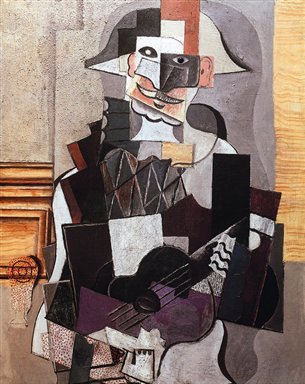Pablo Picasso, Harlequin Playing Guitar, 1914-1918.
Oil on canvas, 98 x 77 cm.
Private collection.
The appearance of reality—so direct and unequivocal—signalled the end of the illusory, hermetic and anonymous style of painting called Analytical Cubism, which Picasso developed for a year and a half in such intimate contact with Braque that the other virtually became his double (to the extent that it is difficult to distinguish between their works of 1910-1911). This new orientation was based on a sharpened sensual perception of the world, a reassessment of its external stimuli: its variety of colours and wealth of material qualities. This fresh vision was also the echo of an internal event indeed capable of transforming perception and thought, the echo of a new love. This rule had long been clearly established: love brought changes to Picasso’s art. Love is what underlies his admiration of textures, for contrasting effects; love is the reason here for the appearance of livelier and more joyful colours. Together with the woman whose very name, Eva, had symbolic meaning for him, Picasso began a new life that introduces new overtones in his art.
